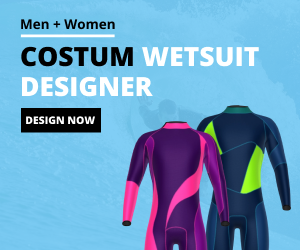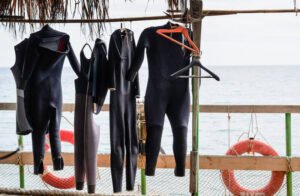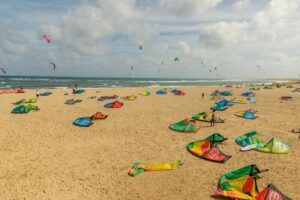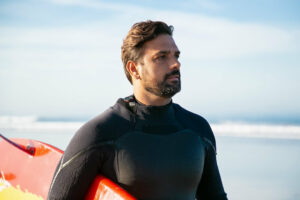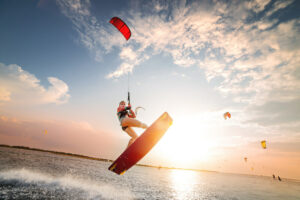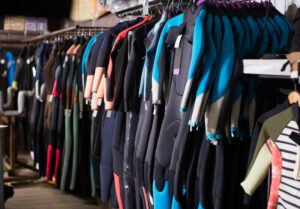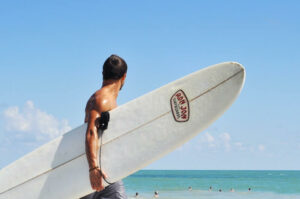You are longing for adrenaline, speed and a cold splash of water in your face? Choosing the right wakesurf board size is the first step to mastering your ride. Whether you’re a beginner seeking stability or a seasoned pro craving high-speed thrills, we’ve got you covered. Dive deeper into this detailed guide, featuring a wakesurf board size chart, and take the first step towards an exciting adventure on the water. Get your tape measure ready, and you are as good as on the waves!
In this article, you will get answers to the following questions:
- What different types of wakesurf boards are there?
- How to pick the right wakesurf board size?
- Which boards are best for beginners?
- And which boards are recommended for advanced riders?
Wakeboarding vs. Wakesurfing
The difference between wakeboarding and wakesurfing is the type of towing device used and whether the surfer holds on to the rope or lets go of it. In wakeboarding, there are two main types: cable wakeboarding and boat wakeboarding.
In cable wakeboarding, you start off by being pulled by an overhead cable system before riding the wake while holding a rope. In boat wakeboarding, you ride the wake behind a motorboat while also holding onto the rope.
Wakesurfing, however, is solely performed by riding the wake of a boat and letting go of the rope. Riding behind a boat allows the rider to go faster and achieve higher jumps. The board designs for boat wakesurfing are much stiffer. Various fin arrangements and base indents give each and every rider options to personalize their riding style.
Which Wakesurf Board Size do I need?
Any foam board will do? Oh no, not at all! Before buying a wakesurf board a bunch of various factors, including your weight, riding style, and skill level need to be considered. The boards on the market vary significantly in length, fins, rockers, and shapes.
We lost you on the term “rockers”? No worries, we will solve each and every question mark in your head, except for one final one – “When do I start?”
Check out the surfboard size, boogieboard size and bodyboard size guides.
The Board Length
The decision between a longer or a smaller board is influenced by various factors. And having to carry it around, is clearly the least important one.
Longer boards, just as in classic surfing, are recommended for beginners. The more material, meaning the thicker and longer a board is, the more buoyancy it offers. But even in circles of advanced riders, more and more wakesurfers prefer a longer board.
Reasons to size up:
- More speed (due to the heightened position in the water)
- Softer landings (more material absorbs more impact)
- More control (because of the bigger contact area of water and board)
- Easier steering (due to increased flexibility)
- Less falling (bigger boards make balancing easier)
Smaller boards require precise control and are more common amongst experienced riders, searching for challenges.
Reasons to size down:
- Preciser maneuvers (coming with the risk of falling when not executed error-free)
- Faster response (enabling for sharper turns)
The Base Designs
As tempting as it is, only going for aesthetics won’t get you far when opting to buy a wakesurf board. It’s essential to choose a board with a base design that aligns with your skill level, riding style, and preferences. Each design offers unique characteristics that cater to different types of wakesurfing experiences.
The three most common designs are the featureless, the channels and the V-line. Each offering distinctive advantages on speed, stability, and maneuverability.
1. The Featureless
As the name may already hint, this design comes without any engravings. It is a plain and smooth base, relying completely on fins and rockers to ensure stability and maneuverability. This type of base provides a consistent and predictable ride, making it ideal for beginners and riders who prefer a simple and smooth experience on the water.
2. Channels
Channels are grooves or indents carved into the base of the wakesurf board. They run along the length of the board and help to improve tracking and stability on the water. Channels enhance edge control, especially during hard cuts and landings, making them popular among intermediate to advanced riders who desire precise control and response.
3. V-Spine
The V-spine is a unique design element that features a V-shaped spine down the center of the wakesurf board’s base. This shape provides smooth water flow and disperses water away from the board, reducing drag and improving speed. V-spine bases are known for their soft landings and forgiving nature, making them a favorite among riders who focus on aerial tricks and want a board that cushions landings.
The Fins
The type and configuration of fins can impact the riding experience significantly. You can experiment with different set-ups. Depending on where and how you are surfing, it can bring a completely new angle to the experience.
Not only the question of fins or no fins is important to make. When attempting to do an obstacle course in a wakesurfing water park, you need to remove the fins or use slider fins. These fins are shorter and more rounded, reducing the risk of catching on rails or kickers during tricks.
In general, you can decide between molded-in fins and removable fins. The removable version brings the clear advantage of multipurpose usage. Park or Boat? No need to decide before purchasing the board.
Yet molded-in fins provide more stability, making them suitable for beginners and riders who prefer a more forgiving ride. Out in the open water, the range to experiment with the influence and advantages of fins is considerably wider.
Depending on the length of the fins, you can gain balance and stability or win maneuverability. Longer fins can give beginners a more predictable ride and increase stability. The shorter the fins, the less traction of the water, allowing for spontaneous moves and more advanced tricks.
Some wakesurf boards only have a more pronounced and longer center fin. This design provides increased stability and tracking, making it easier for riders to maintain a straight path while riding.
Furthermore, you can play with the fin’s angles as well as with their shape. Canted fins have an angle or cant to them, meaning they are not perpendicular to the wakesurf board’s base. This design offers enhanced edge control and responsiveness, allowing riders to make sharper turns and carve with precision.
Designed for advanced riders, deep-V fins enable higher speed and more aggressive turns. These fins have a V-shaped profile, where the center of the fin is deeper than the edges, resembling the letter “V.”
Not only does the V-shape reduce drag and improves tracking and stability features of the board. It also increases the edge control considerably.
Wakesurfers can apply more pressure to the edges of a deep-V fin board, resulting in improved responsiveness. This allows for quick transitions and precise edging during tricks and jumps.
Fins are a great opportunity to get creative with your personal board set-up. Especially for beginners, finding a set-up that gives you balance and confidence is the key to a felicitous wakesurfing debut.
Rockers and Edges
A rocker in wakesurfing refers to the curvature of the wakesurf board from tip to tail. More or differently placed water contact can affect the board’s performance and riding characteristics remarkably.
There are four main types of rocker profiles used in wakesurf boards:
- Continuous Rocker: This type of rocker features a smooth and continuous curve from tip to tail. It is most popular amongst beginners and intermediate riders. It offers stability, reliable tracking, and easy transitions between edges.
- 3-Stage Rocker: A 3-stage rocker has a more distinct shape, featuring three rather straight areas. It almost looks like someone took a completely flat board and folded up tip and tail in a 45° angle. The 3-stage rocker allows for explosive take-offs and higher jumps, but over all slows the board down, due to its non-aerodynamic shape.
- Camber Rocker: In snowboarding, a camber rocker is a profile where the center of the snowboard is raised off the ground while the tip and tail touch the ground. This creates a slight arch or curve in the snowboard’s shape. It is a relatively new shape in wakesurf boards, but is a growing trend amongst intermediate and advanced riders. Camber rockers provide better edge hold and responsiveness, making them ideal for carving and aggressive riding.
- Hybrid Rocker: This shape is an equal mixture between the first two rockers. It combines the smooth, round edges of the continuous rocker with the higher folded up tip and tail of the 3-stage rocker. The hybrid rocker can be used in the park as well as behind the boat.
Depending on your riding style, you can choose between sharper and softer edges. The sharper the edges, the more aggressive you can tackle the waves. On the other hand, round edges are better suited for laid-back riders, providing smoother sliding onto the surface and enhancing the focus on surface tricks.
Wakesurf Board Size Chart
A wakesurf size chart provides guidance on picking the appropriate wakesurf board size based on the rider’s weight, height, and skill level. Simply find the right row and column, aiming at your weight, consider your height, and the perfect board size is basically guaranteed.
| Rider Weight (lb) | Shorter Wakesurf board Size (cm) | Longer Wakesurf board Size (cm) |
| 25-70 | 111-118 | 118-128 |
| 40-85 | 118-130 | 130-140 |
| 65-110 | 124-134 | 134-144 |
| 70-130 | 130-138 | 138-148 |
| 150-225 | 138-146 | 146-156 |
| 170-250 | 142-146 | 148-156 |
| 200-275 | 146x | 166+ |
Please note that wakesurf board size charts may vary slightly among different manufacturers and models. It’s essential to consider the specific chart provided by the wakesurf board brand you are interested in to ensure an accurate and suitable selection. Additionally, personal preferences as described earlier may influence your board length choice.
What you should know about the wakesurf board size
The real question is, what you should not know about choosing the right size. And the simple answer is: Nothing! It’s important to be well-informed and avoid relying on possible misinformation or simply picking the cheapest board available. Riding an ill-fitting board will only take away the fun wakesurfing can bring.
No. 1: Invest those 5 minutes
Don’t rush the process. Invest the extra time to figure out the perfect size for you. Measure your weight, refer to the sizing table, and find your ideal fit. Every second of preparation will be worth it once you’re out in the water with a board that suits you perfectly.
No. 2: Trust the process
Nobody was born to be real Aquaman – we all must start somewhere. Failing, falling and trying again are part of the learning curve. Sooner or later, the first stumbling attempts will be a fading memory.
No. 3: Come prepared
Do your research, whether it’s about the surf area or buying a board. Gather as much information as possible to be able to make an educated decision. Not all store owners are wakesurf board surfers themselves, so come prepared, know what you want, and remain open for advices people may offer.
Conclusion: The perfect match – which board should you get?
Choosing the right wakesurf board size is a critical factor in ensuring a fantastic wakesurfing experience. By considering your weight, skill level, riding style, and the specific wakesurf board size chart provided by the manufacturer, you can confidently select a board that perfectly suits your needs.
Whether you’re a beginner just starting or an experienced rider looking to upgrade, the right wakesurf board size will make all the difference in unlocking your full potential on the waves.
As a beginner, you primarily will want to focus on finding confidence and balance on your board. Selecting a bigger board with longer fins and softer edges can give you the right amount of security and the range of motion to try out steering and first jumps.
The further your learning curve rises, the more experimental you can design your board’s set-up. Sharper edges and canted fins in combination with a smaller board offer you the mobility and quick response it needs to achieve higher speed, advanced maneuvers and precise tricks.
Discover the perfect wakesurf board size that will propel you into a world of thrilling rides, endless smiles, and unforgettable moments on the water. So you can embrace the perfect fit, chase the waves, and let the magic of wakesurfing take you on a ride of a lifetime!
FAQ – Most asked questions about wake surf board size
Sizing up and down on a wakesurf board can have multiple reasons. Bigger boards offer more buoyancy, stability, and cushioning for landing after jumps. Smaller boards respond faster, making turns and tricks sharper. The smaller and lighter you are, the smaller the board should be. To learn how to select the perfect board length, check the wakesurf board size chart in the previous chapters.
For newcomers to wakesurf board surfing, the best type of wakesurf board is typically a larger, more stable, and forgiving board. A board with these characteristics will make it easier for new riders to learn the basics, gain confidence, and progress their skills.
→ Look for a board with a size in the range of 4’10” to 5’6″ for adult beginners, and slightly smaller for youth riders.
→ Consider a board with a traditional surfboard shape, which offers a balanced and predictable ride.
→Look for a wakesurf board with a mellow rocker profile. A flatter rocker provides a more stable platform and easier entry onto the wave.
For advanced riders in wakesurfing, selecting the right wakesurf board involves considering their specific riding style, skill level, and desired performance characteristics. Advanced riders typically seek boards that offer more responsiveness, maneuverability, and the ability to perform advanced tricks and maneuvers.
→ Board sizes for advanced riders typically range from 4’6″ to 5’4″.
→ Advanced riders may prefer wakesurf boards with more aggressive shapes, such as narrower profiles and sharper rails.
→ Shapes like a 3-stage rocker and smaller fins allow for higher jumps and increased maneuverability.
Even after following the guide and selecting a board that matches your weight and skill level, it’s natural to feel a bit uncertain about your choice. If possible, try to demo or test different wakesurf boards before making a final decision. Demoing boards allows riders to feel the board’s performance on the water and determine which one best suits their riding style and preferences.



